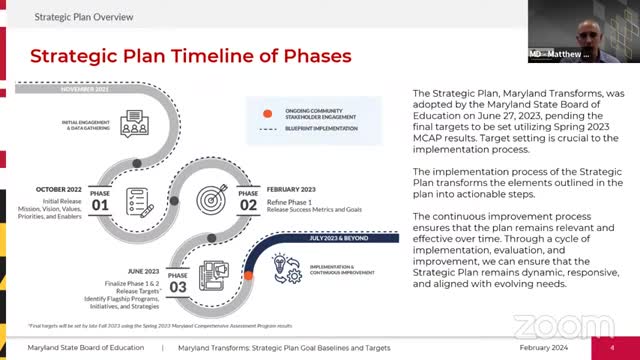Maryland education officials unveil 2023-2026 strategic targets for student readiness
February 15, 2024 | Maryland Department of Education, School Boards, Maryland

This article was created by AI summarizing key points discussed. AI makes mistakes, so for full details and context, please refer to the video of the full meeting. Please report any errors so we can fix them. Report an error »

The Maryland Department of Education's Education Transformation & Accountability Committee convened on February 15, 2024, to discuss significant revisions to educational goals and targets aimed at improving student outcomes across the state. The meeting highlighted a strategic shift in how the department plans to measure and enhance educational performance over the next few years.
One of the key decisions made during the meeting was the proposal to revise the language surrounding educational priorities. The superintendent suggested expanding the number of priorities from four to eight, emphasizing a more focused approach to educational goals. This change aims to clarify objectives and enhance public understanding of the department's initiatives.
The committee also established a baseline for the 2022-2023 school year, which will serve as a reference point for setting ambitious yet achievable targets through 2025-2026. For instance, the goal for kindergarten readiness is to increase the percentage of students demonstrating readiness from 41% to 55% over three years. Similarly, the target for third-grade English Language Arts proficiency is set to rise from 48% to nearly 55%.
In addition to academic readiness, the committee addressed critical indicators of student well-being. The goal is to reduce the percentage of middle school students meeting at-risk criteria—such as chronic absenteeism or failing grades—from nearly 47% to 32% within three years. This focus on holistic student development reflects a commitment to not only academic success but also social and emotional well-being.
The meeting also touched on the importance of diversifying the teaching workforce. The committee aims to increase the percentage of new teachers of color from 43% to 48% over the next three years, aligning with the demographic makeup of Maryland's student population.
Furthermore, the committee discussed metrics for low-performing schools, setting a target to reduce the percentage of schools re-identified as low performing from 81% to 60% by 2026. This goal underscores the department's commitment to improving educational equity and support for underperforming institutions.
As the Maryland Department of Education moves forward with these initiatives, the committee plans to gather feedback from local education agencies and stakeholders to refine these targets further. The next steps include a review of these goals at the upcoming board meeting, ensuring alignment with broader state educational outcomes and accountability measures.
These developments signal a proactive approach to educational transformation in Maryland, with a clear focus on measurable outcomes that aim to enhance the quality of education for all students in the state.
One of the key decisions made during the meeting was the proposal to revise the language surrounding educational priorities. The superintendent suggested expanding the number of priorities from four to eight, emphasizing a more focused approach to educational goals. This change aims to clarify objectives and enhance public understanding of the department's initiatives.
The committee also established a baseline for the 2022-2023 school year, which will serve as a reference point for setting ambitious yet achievable targets through 2025-2026. For instance, the goal for kindergarten readiness is to increase the percentage of students demonstrating readiness from 41% to 55% over three years. Similarly, the target for third-grade English Language Arts proficiency is set to rise from 48% to nearly 55%.
In addition to academic readiness, the committee addressed critical indicators of student well-being. The goal is to reduce the percentage of middle school students meeting at-risk criteria—such as chronic absenteeism or failing grades—from nearly 47% to 32% within three years. This focus on holistic student development reflects a commitment to not only academic success but also social and emotional well-being.
The meeting also touched on the importance of diversifying the teaching workforce. The committee aims to increase the percentage of new teachers of color from 43% to 48% over the next three years, aligning with the demographic makeup of Maryland's student population.
Furthermore, the committee discussed metrics for low-performing schools, setting a target to reduce the percentage of schools re-identified as low performing from 81% to 60% by 2026. This goal underscores the department's commitment to improving educational equity and support for underperforming institutions.
As the Maryland Department of Education moves forward with these initiatives, the committee plans to gather feedback from local education agencies and stakeholders to refine these targets further. The next steps include a review of these goals at the upcoming board meeting, ensuring alignment with broader state educational outcomes and accountability measures.
These developments signal a proactive approach to educational transformation in Maryland, with a clear focus on measurable outcomes that aim to enhance the quality of education for all students in the state.
View full meeting
This article is based on a recent meeting—watch the full video and explore the complete transcript for deeper insights into the discussion.
View full meeting
